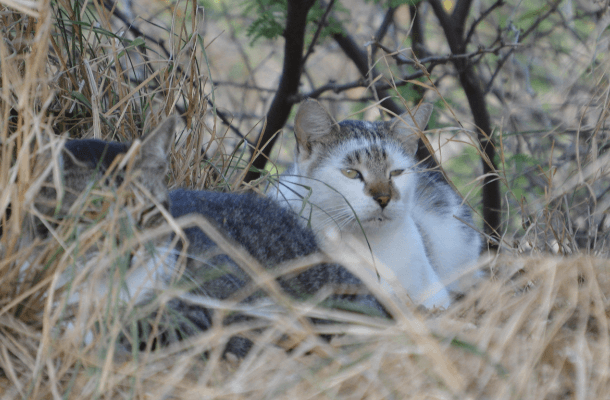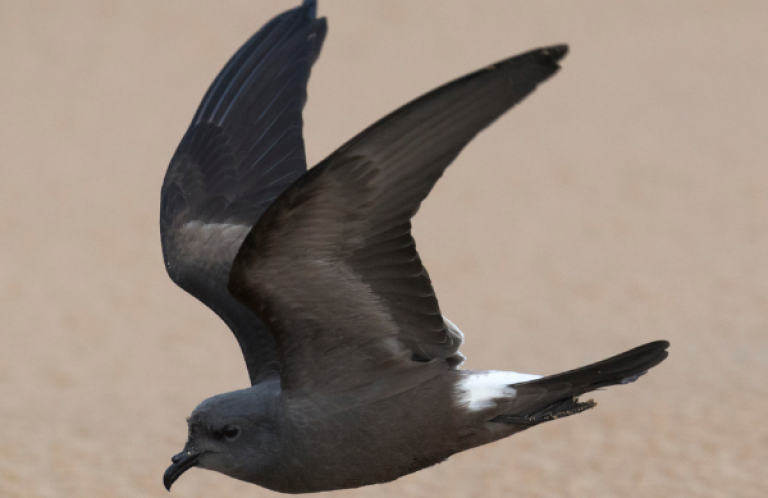Oʻahu's Public Lands Contaminated with Cat Parasite
Media Contact: Jordan Rutter, Director of Public Relations, 202-888-7472 | jerutter@abcbirds.org | @JERutter
Expert Contact: Grant Sizemore, Director of Invasive Species Program, 202-888-7480 | gsizemore@abcbirds.org

Feral cats found at Koko Head District Park on Oʻahu, one of the sites where cat feces tested positive for Toxoplasma gondii. Photos by Grant Sizemore
(Washington, D.C., April, 9, 2020) A new study published in Conservation Science and Practice documented contamination of Oʻahu's public lands with the parasite Toxoplasma gondii, which causes the disease toxoplasmosis and is a serious health risk for people and wildlife. Cats, which are not native to Hawai‘i, are the exclusive source of T. gondii found in the state's environment.
Researchers surveyed public lands for colonies of cats near 32 important bird areas across Oʻahu. The parasite was identified in over 10 percent (6/56) of cat feces samples and at 75 percent (3/4) of locations where feces were collected, including Heʻeia State Park, Koko Head District Park, and Lagoon Drive. The authors acknowledged that this is likely an underestimate of total T. gondii present.
“The high percentage of T. gondii-positive feces samples suggests that Oʻahu's cats are contributing large quantities of this infectious parasite to parks and neighborhoods across the island,” said Grant Sizemore, Director of Invasive Species Programs at American Bird Conservancy and study co-author. “What's particularly worrying is that these hardy oocysts move through the environment with the potential to infect any warm-blooded species in terrestrial, freshwater, or marine ecosystems.”
Research indicates that a single cat can excrete up to hundreds of millions of infectious oocysts, and a single oocyst accidentally ingested or inhaled can cause infection. Infection in people can yield health impacts from flu-like symptoms to death. Over 1 million people are newly infected with this parasite in the U.S. every year, including over 21,500 ocular cases, which can cause blindness.
Recent reports from the National Oceanic and Atmospheric Administration (NOAA) underscore the seriousness of T. gondii infection. At least 13 Endangered Hawaiian Monk Seals have died in recent years from toxoplasmosis, including one that died in February 2020 and another earlier this month. Three seals died in the same week on Oʻahu in 2018 alone. NOAA reports that “it is becoming increasingly clear that Hawaiian monk seals are suffering from localized lethal outbreaks of this cat-borne disease.”
Hawaiʻi's native birds are also at risk, doubly so due to the simultaneous threat of cat predation. T. gondii has been identified in the highly endangered ʻAlalā on the Big Island and Nēnē on Kauaʻi, Maui, and Molokaʻi. Cats have also been documented killing a wide variety of Hawaiʻi's endemic and threatened birds, including ʻIʻiwi, Palila, ʻUʻau, and more throughout the Hawaiian Islands. The Hawaiʻi Invasive Species Council lists feral cats among the top invasive species threats in the state.
In the current study, researchers found that 78 percent (25/32) of public lands had cat colonies and that 72 percent (23/32) showed signs of people purposely supporting cats on these lands (e.g., feeding). As many as 99 cats were observed at one location.
This research builds upon a recent study in Pacific Science that examined additional sites around Oʻahu. That study found T. gondii at Kaʻena Point and the University of Hawaiʻi at Mānoa, which increases the risk of infection to monk seals, other wildlife, and people. “As sampling efforts have increased, we are finding more and more sites with toxoplasmosis, suggesting it is widespread across Oʻahu and likely all the islands with significant feral cat populations,” said Dr. Chris Lepczyk, Auburn University professor and lead author on the current study. “What we need to do is remove feral cats from the landscape in order to eliminate T. gondii.”
The City and County of Honolulu in recent years implemented a trap, neuter, release (TNR) program for cat control. Under this policy, stray and feral cats are trapped, sterilized, and then released back to the landscape where they were found. Though intended to reduce the cat population, this program perpetuates the persistence of cats – and their feces – on the landscape.
“Cats can be wonderful pets, but they are also incredibly effective non-native predators that have no business roaming Hawaiʻi,” said Sizemore. “It's long past time that these cats were effectively managed, which includes addressing disease risks. Simply sterilizing cats and dumping them back outdoors isn't reducing cat populations and actually contributes to the T. gondii infection risk.”
###
American Bird Conservancy is a nonprofit organization dedicated to conserving birds and their habitats throughout the Americas. With an emphasis on achieving results and working in partnership, we take on the greatest problems facing birds today, innovating and building on rapid advancements in science to halt extinctions, protect habitats, eliminate threats, and build capacity for bird conservation. Find us on abcbirds.org, Facebook, Instagram, and Twitter (@ABCbirds).


















































